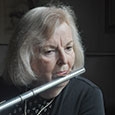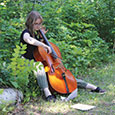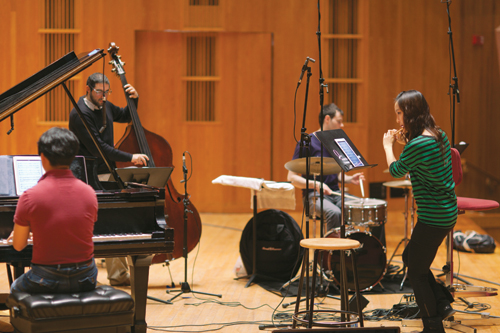
In December 2011 flutist Jasmine Choi was named Proud Citizen of the Year in her home town of Daejon, Korea. This talented musician came to the United States and entered the Curtis Institute of Music at the age of 16 on a full-scholarship. There she studied with the legendary Julius Baker who called her “a huge sensation.” She studied with him for four years until his death in 2003. Currently Choi is associate principal flute with the Cincinnati Symphony Orchestra, a position she won at the age of 22.
She holds a bachelor’s degree from Curtis and a master’s degree from the Juilliard School where she studied with Jeffrey Khaner. Upon her graduation, she worked with Thomas Robertello. In addition to her orchestral position, Choi performs as a soloist both in the United States and around the world.
.jpg) When did you become interested in music?
When did you become interested in music? In the third grade at my school, all students learned the recorder. I was given an assignment to play a song for the music class and became obsessed with the recorder. Playing the recorder was fun. It wasn’t like practicing the violin which I had begun to study with my mother. I played night and day. My parents worried about my disturbing the neighbors and told me that ghosts would haunt me if I continued to play the recorder all the time.
I learned the tune for the class and then continued playing by ear. My repertoire included children’s tunes, cartoon music, and violin repertoire I had heard my mother playing and teaching. My frustration was that I had only learned a single octave of notes on the recorder, and wanted more to play the music I heard in my head. There was a girl who was about three years older and lived a floor higher in our apartment building. I could hear her playing the flute and thought maybe I should try it because it seemed like the flute had more notes than the recorder.
At my Catholic elementary school each child chose an instrument, so I selected the flute. Each day 20 minutes was spent in orchestra, band, or private lessons, six days a week. I enjoyed playing the flute so much more than the violin because my mother did not know much about the flute and was in awe of my accomplishments. When I played the violin, she was always correcting me. I progressed rapidly and knew that the flute was my passion in life. I performed the Haydn D Major Concerto for my first solo appearance with orchestra about this time.
I practiced all the time and progressed faster than my classmates. I was worried about what music studies would be like in middle school and decided to audition for an Arts Middle School in Seoul, which was two hours away from Daejon. I was accepted into the program but was only 12 years old. My family arranged for me to stay with a cousin, whom I had never met. She was single, in her late 20s, and a workaholic. The business culture in Korea is such that after work you go out with colleagues until late in the evening, so I was left alone most of the time.
What was it like to be on your own at the age of 12?
I was lonely and homesick and couldn’t eat. My diet consisted of bread and orange juice, and I practiced day and night. It was a difficult time. Unlike most Asian parents, when my parents called, they told me to stop practicing and go to bed. However, when I practiced, I forgot how lonely I was. I told myself that I had come all this way to study flute, so I had better work harder than the other students and do really well.
As I approached high school, I realized that the curriculum at the next school was not going to change. It would continue to be the same as middle school: a jury piece, a recital selection, and the same competitions. I felt trapped in a little world. I decided I would go study in America.
My parents had been opposed to my studying in Seoul and now again did not want me to go to America. However, they eventually arranged for me to stay with some distant relatives in Staten Island, New York, so off I went. I ended up in a private school that had few Asian students and no music program. I continued to practice and tried to figure out what I should do. About half-way through the year, I learned about the program at Curtis. The admissions materials said you did not have to be a high school graduate to enter the program, but there was only one opening per year. I had to win that place for the next year.
I practiced day and night, auditioned, and was accepted into the class of Julius Baker and Jeffery Khaner. I was 16 years old. Curtis had an arrangement with a Philadelphia high school so I could earn my high school diploma while beginning the program at Curtis. What was even better was that the administration said I could live on my own.
What were lessons like with Julius Baker?
The first few months I practiced non-stop because I worried the school had made a mistake in admitting me. Baker gave me freedom and made me find my own voice. His assignments were demanding. For example, he often had me learn a new piece each week complete with accompaniment. I had so many questions. In my lesson I would play a phrase four different ways and ask him which he liked best. He told me all were very nice, but it was important for me to pick what I liked. He often said, “the best teacher is yourself.” He encouraged me so much and was like a nice grandfather. The worst comment he ever made to me was “not bad,” but mostly he would say “amazing” or “you made my day.” I began to judge my playing by the level of his compliments. Sometimes he would call at 6 a.m. and say “how wonderful you played yesterday.” I would let the voice mail take the message and call him back later in the morning. He would ask, “where were you.” “Sleeping, I would reply.”
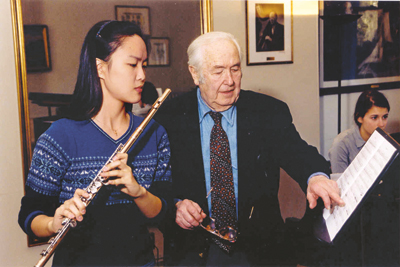
Baker came to Philadelphia each Wednesday afternoon. He taught two students on Wednesday afternoon and two on Thursday morning. My lesson was always 8 a.m. on Thursday mornings, but he wanted me to join him for breakfast at 7. As I rushed to meet him at the restaurant, storekeepers would yell, “Mr. Baker was just asking where you were.” Everyone in the area around Curtis knew who the faculty was. I would look at my watch noting that I still had time to spare to make the 7 a.m. breakfast. In all those years, I was never late.
What else did you learn there?
Otto-Werner Muller was the conductor of the Curtis Orchestra and the conducting professor. Once a week conducting students worked with the lab orchestra under his guidance. Much of the repertoire was repeated from year to year such as all the symphonies of Beethoven and Brahms. By the time I graduated, I had played these works many times. If you paid attention, you knew how to apply Muller’s concepts when performing them.
We also got to work with some of the biggest names in the orchestral conducting world. Whoever was in town conducting the Philadelphia Orchestra also worked with the Curtis students on the same repertoire the Philadelphia Orchestra was performing. The schedule was the same each week: Monday: Wind class with Richard Woodhams, the oboe professor; Thursday: Complete orchestra rehearsal with the staff conductor; Saturday morning: Perform the repertoire for Curtis patrons and donors with the guest conductor; and Saturday evening: Attend the Philadelphia Orchestra concert performing the repertoire we had studied during the week. We were given free tickets to the concerts each week.
Chamber music was also an excellent experience. Everyone was so eager to play. You selected the piece you wanted to perform, assembled a group, and requested a coach. If the coach agreed, he or she met with you weekly until the performance. Imagine coaching with Jennifer Higdon, Gary Graffman, Michael Tree, or Stephen Tenenbom among others.
At Curtis there are no juries, only student recitals. You could perform as little or as much as you wished. No one pushes you, it is your choice. Each and every recital performance was recorded and placed in the Curtis archives. This meant you could listen to famous musicians when they had been students at Curtis, but this also meant that future students could listen to you. This placed a lot of responsibility on you to produce your best work.
What repertoire did you study at Curtis?
The first year I studied works by Prokofiev, Reinecke, Ibert, Nielsen, Jolivet, Feld, Dubois, Sancan and similar pieces. The second year I completed most of the works of the standard flute repertoire, and the third year I began making transcriptions of works from the violin repertoire. These included the Franck Sonata, Dvorak Sonatina, Mendelssohn Concerto and Tchaikovsky Concerto.
With Mr. Khaner, I explored different etudes including those by Paganini, Bozza, Casterede, Bitsch, Chopin/Moyse, Andersen, and Karg-Elert. One mistake in playing them, and it was back to the top. It is interesting that I was Baker’s last student at Curtis and Khaner’s first at Juilliard. I learned a tremendous amount from Mr. Khaner both at Curtis and Juilliard. He really made me become the musician I am now. I still play for him these days, and, I still call him Mr. Khaner.
Have you ever had an injury?
One fall semester at Curtis my right hand began bothering me. Curtis arranged for me to see around 20 different doctors. One thought I had focal dystonia; another thought something else. I did not play for an entire semester. At Christmas I went home to Korea. I rested and ate good food. When I came back for the spring term, I could play again. I am not sure what happened, but I am extremely thankful that whatever it was cured itself.
What was your audition like for the position in Cincinnati?
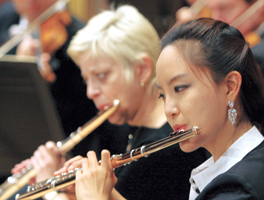 I had just graduated from Juilliard and was looking forward to beginning a career as a free-lancer in New York City. The audition was a few days after the end of the term in which I had learned the 47 excerpts for the final jury. I flew to Cincinnati, not even sure where it was.
I had just graduated from Juilliard and was looking forward to beginning a career as a free-lancer in New York City. The audition was a few days after the end of the term in which I had learned the 47 excerpts for the final jury. I flew to Cincinnati, not even sure where it was.
 I had just graduated from Juilliard and was looking forward to beginning a career as a free-lancer in New York City. The audition was a few days after the end of the term in which I had learned the 47 excerpts for the final jury. I flew to Cincinnati, not even sure where it was.
I had just graduated from Juilliard and was looking forward to beginning a career as a free-lancer in New York City. The audition was a few days after the end of the term in which I had learned the 47 excerpts for the final jury. I flew to Cincinnati, not even sure where it was. I played the first round and was not nervous at all. Then I was asked to play the next round and the next. In a strange way I was afraid I was going to win. At the end when there were just two of us left, I assumed they would call my friend’s name, but they called mine. I was shocked and just said, “ok, thank you.” When each member of the jury came up to congratulate me, I was still so shocked that I showed no expression on my face. Several asked if I was happy. After I returned to New York, it took me a week to tell anyone that I had won the audition. The position was for one year, and about half-way through the year, they advertised the job again. By this time I knew how fortunate I was to have this position and loved everything about it. I wanted to win the audition again so I practiced and practiced. In Cincinnati the screen stays up through the final rounds. When it finally came down, and my colleagues saw I had won, we were all overjoyed.
I won the position when I was 22 and have been playing there for the past six years. I love my job and my colleagues. Randy Bowman is the principal flute, and I am so lucky to work with him. I am also pleased to be the first Korean woodwind player to hold a post with a major orchestra in the United States. Randy and I share each masterwork concert. If there are more flute parts than usual, I may play piccolo or alto flute. Recently I played alto flute on Stravinsky’s Rite of Spring and Ravel’s Daphnis and Chloe.
What are some recordings you have made?
When I was a student at Curtis, I attended a music festival in Japan. While there I played the Mozart Flute and Harp Concerto with Xavier de Maistre, former principal harpist of the Vienna Philharmonic. In 2006 I was going to record the Mozart D major Concerto as well as the Flute and Harp Concerto. My manager asked Xavier if he would record with me and he agreed. The recording turned out quite well. My second recording Fantasy is now out on iTunes and Amazon. I recently recorded Claude Bolling’s Suite for Flute and Jazz Trio and Gary Schocker’s Winter Jasmine. Schocker wrote this piece for me. The recording will be released in the summer of 2012.
What upcoming solo performances do you have planned?
The Cincinnati Symphony Orchestra is a 52-week orchestra; however we have 10 paid vacation weeks a year. During this time, I play recitals and concertos and make recordings. I will play the Uriel Vanchestein Concerto for Flute and Clarinet (world premier) and my transcription of the Saint-Saens Introduction and Rondo Capriccioso with the New York Classical Players on February 4th in New Jersey and February 5th in New York. (www.newyorkclassicalplayers.org) In August I will attend my first N.F.A. Convention where I will play a solo recital and share a recital with Thomas Robertello.
What do you practice?
I practice the basics. I might warm-up on something like the Bach Partita or one of the Paganini etudes and then work on fundamentals. Sometimes my practice is all about one note. I do scales from the Taffanel & Gaubert and also play some of my favorite tunes. I rest every hour, often going outside to get some fresh air and to have a coffee.
Do your neighbors ever complain about your practicing?
The first year I moved into this apartment building my neighbors loved to hear me practice. They thought it was interesting that I played in the symphony and would often attend concerts. Then some new people moved in. The first day they were there, they slipped a note under the door that said, “Whatever you are playing, (Is it a flute? a clarinet?), it needs to stop.” The note continued, “You should keep playing though, because you may have some talent.” I try to practice when they aren’t home. If I have a lot to do, then I go to my church and practice.
Finding a suitable place to practice has always been a challenge. When I was at Curtis, I practiced in a walk-in closet and while studying at Juilliard in the late evenings I used an empty kid’s playroom in the lobby of my apartment building. When you really want to do something, you somehow always find a way to do it.
Do you have advice for students?
Playing the flute is not a “you-just-play-way-better-when-you-wake-up-next-day” sort of thing. It is such a long, ongoing process that truly takes a lot of time and patience. It is always so exciting and fun when you start anything new, but I think only people who have a true passion and sincere love for the flute can keep going without feeling exhausted or in despair. It is so important to remember how much you love playing. Just be patient and keep focusing on the joy of playing. As long as you love doing it, good things will come to you sooner or later. What a blessing it is to do what we love every day.
* * *
Advice for Orchestral Playing
Orchestral playing presents many musical challenges: solo moments, chamber music sections, and tutti sections where the entire orchestra plays. A good orchestral player is able to shift back and forth automatically as the demands of the piece change. I have learned tremendously since I joined the Cincinnati Symphony in 2006 and am still learning and improving at every rehearsal and every concert. As you work on orchestral works or the list of excerpts on page 11, consider the following ideas.
1. Know the score inside out.
Remember the flute part is just a tiny portion of a gigantic artwork. You should know the full score as if you were going to conduct the orchestra. This means you know who is accompanying your solo and know what is happening when you are not playing at all.
2. Work on the details.
Being able to control the details is what distinguishes a good player from a great player. Some elements to consider are tone, articulation, phrasing, technique, breath control, rhythm, intonation, vibrato, tempo, and posture.
3. Be flexible.
Playing in an orchestra means playing together. You might be asked to play a passage differently at any given moment. Try to prepare with different tempos, phrasings, and interpretations. It is also important to listen to more than one recording of
a piece.
4. Express who you are and be yourself.
Don’t be afraid to show your personality and your own color. There is no right or wrong answer, which is what makes music so charming. In the end, just go on stage and enjoy playing.
Choi’s Excerpt List
While at Juilliard, I studied orchestral excerpts. I think for one jury I learned something like 47 excerpts. The following are some that students would do better to learn now than later.
Bach: St. Matthew Passion, Soprano Aria, No. 58 “Aus Liebe will mein Heiland sterben”
Bartok: Concerto for Orchestra
Beethoven: Symphonies No. 3, 4, and 7, and Leonore Overture No. 3
Brahms: Symphonies No. 1 and 4, Variations on a Theme by Haydn, Op. 56A
Debussy: Prelude a l’apres-midi d’un faune
Dvorak: Symphonies No. 7, 8, and 9
Hindemith: Symphonic Metamorphosis
Mahler: Symphony No. 9, Das Lied von der Erde
Mendelssohn: Symphony No. 4, Incidental Music to A Midsummer Night’s Dream
Mozart: The Magic Flute
Prokofiev: Classical Symphony, Symphony No. 5, Peter and the Wolf
Ravel: Daphnis et Chloe, Bolero
Rossini: William Tell Overture
Saint-Saens: Carnival of the Animals
Strauss: Salome, Dance of the Seven Veils; Till Eulenspiegel’s Merry Pranks, Op. 28, Der Rosenkavalier, Op. 59; Sinfonia Domestica, Op. 53
Stravinsky: Firebird Suite, Petrouchka, Chant du Rossignol
Schumann: Symphony No. 4
Smetana: Overture to Bartered Bride
Tchaikovsky: Symphony No. 4, Sleeping Beauty Ballet
Jeffrey Khaner’s Exercise for Tone, Vibrato, and Breath Control
This is a very helpful exercise that Jeffrey Khaner taught me. Using the following music example, try the steps below.

Instructions:
1. Start with the metronome set at 60 to the beat. As your skills improve, lower the setting to 59, 58, etc.
2. Continue the chromatic half-step pattern descending to low C. Repeat ascending to high C.
3. Play it forte the first time, and piano the second time.
4. Place four (five, six) vibrato cycles on each beat.
5. The length of the fermata should be for as long as you can play the note. When you begin this exercise, the fermata may be 12 counts; build it up eventually to 16, 20, 24, etc.
6. When you think you need to breathe, play for five counts more.
7. Relax and breathe between each set of two notes.
Jeffrey Khaner is principal flute of the Philadelphia Orchestra and the Flute Professor at the Curtis Institute and the Juilliard School of Music.

